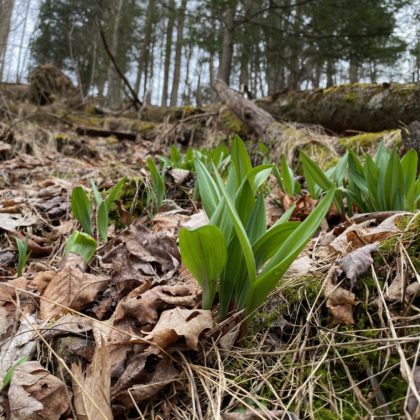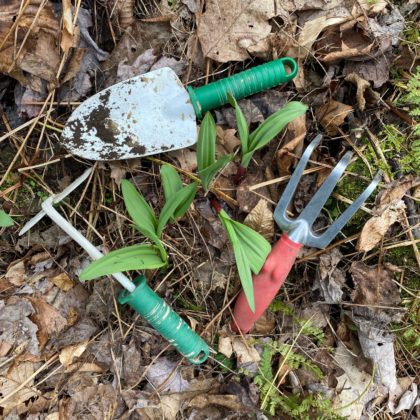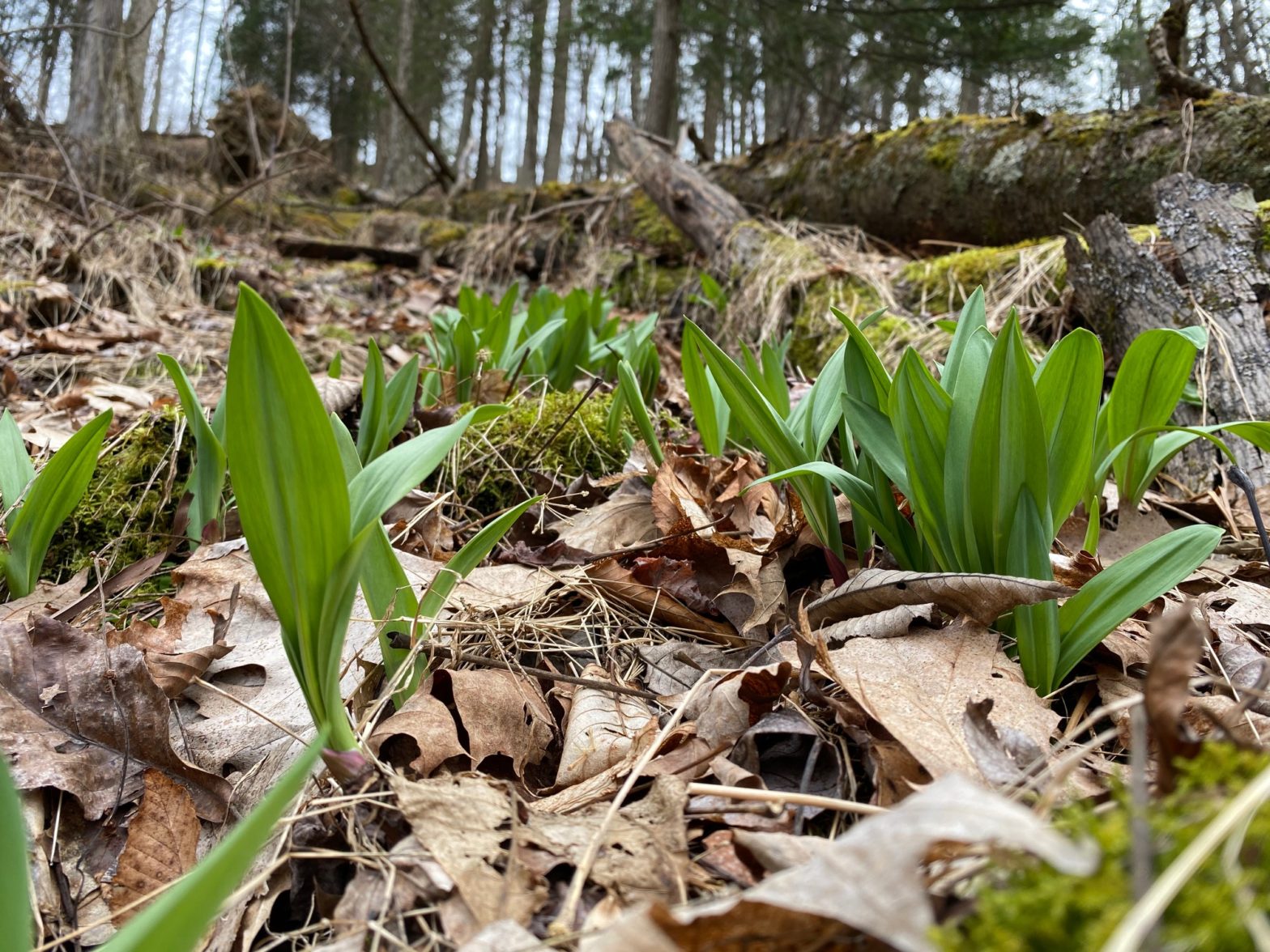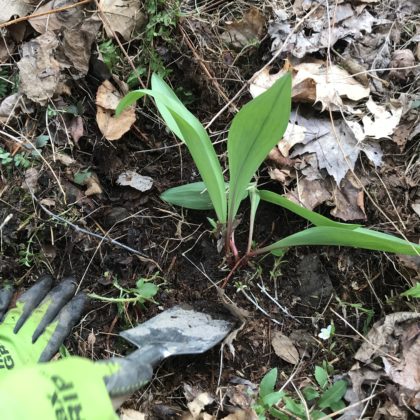It’s springtime in Randolph County and that is not the only season that’s upon us. For many Appalachians, it is also “ramp season”. If you are not from West Virginia or Appalachia you might have never heard about this strange, yet delicious wild plant. Ramps are a native species to West Virginia and are the first edible green of the season. Digging and eating ramps in the spring is a traditional activity throughout Appalachia, especially in gateway communities of the Monongahela National Forest. If you choose to go rampin’ in Randolph County, here are a few tidbits to help with your foraging:

Chasing the flavor: Ramps, scientific name Allium tricoccum, are a member of the lily family which includes onions, garlic, leeks, and other wild edibles. For most people, ramps are either the “holy grail of wild edibles” or for others they hate the flavor and/or smell. There really is no in-between. It’s hard to describe the exact flavor of this plant, but in our opinion it is a mix between an onion and a garlic with a hint of sweetness. The pungent smell of ramps — and of those who’ve eaten them — has been known to clear a room. Different types of ramp cuisine can be found in our local restaurants during this season. Ramps have no bounds in the cooking world; toss them in bacon grease, eat them raw, sauté them with fried potatoes, pickle or can them, freeze them or use them in soups, scrambled eggs, or with beans and cornbread, and some even make ramp wine, jelly, and jam.

Location, location, location: Ramps are among the first green things to emerge out of the ground in the spring. Native to the hardwood forests of the eastern United States as well as eastern Canada, ramps are especially common in the Appalachian mountains. In Randolph County, you can find an abundance of them in the Monongahela National Forest. Ramps normally grow in the moist, shady areas of northern-facing hillsides during the months of March and April.
Ramp recognition: The best way to identify ramps is their location as mentioned above. Ramps look like scallions, but they’re smaller and slightly more delicate, and have one or two flat, broad leaves with a slight stripe of purple at the base of the plant. Important to note, ramps do have a look-a-like, called the lily-of-the-valley. The easiest identifier by far is to tear the leaf and smell it. Ramps will have a strong smell and the lily-of-the-valley has no smell. Another way to identify the difference is the appearance, the lily-of-the-valley has a flower stem and ramps do not until much later in the season. People collect both the leaves and spicy bulb of the plant as a spring tonic, a tradition the early settlers may have learned from Native Americans. Because they appear early in the season and are packed with nutrients they were an important fresh nutritional supplement for mountain inhabitants whose winter diets consisted of dried foods like beans and corn and lacked fresh vegetables.
Keeping the tradition the right way: With demand for the wild ramps increasing, harvesting is affecting native populations. You can practice traditional ramp harvesting and dig small clumps of ramps out of larger patches, leaving behind enough plants to form new patches. Remember, collecting plants for personal use is permitted within the Monongahela National Forest. Personal use is defined as two gallons per person (equaling about 180 whole plants) in possession at any one time (typically the amount that fits into a grocery bag). By following the US Forest Service guidelines, we can ensure that our children and grandchildren will be able to enjoy ramps for generations to come.
plants to form new patches. Remember, collecting plants for personal use is permitted within the Monongahela National Forest. Personal use is defined as two gallons per person (equaling about 180 whole plants) in possession at any one time (typically the amount that fits into a grocery bag). By following the US Forest Service guidelines, we can ensure that our children and grandchildren will be able to enjoy ramps for generations to come.
– Collect ramps only in patches with more than 100 plants.
– If you find a patch that has already been harvested, move on to another area.
– When collecting ramps from a large clump, take only one-fifth of the plants. Leaving behind the majority of the plants will allow them to mature and go to seed, and the patch will recover faster.
– If digging bulbs, use a soil fork or a small hand trowel and a knife, rather than a large shovel. Shovels disturb the root system of neighboring ramps and other plants much more than these smaller tools. To dig ramps, loosen the soil with the soil fork or hand trowel and use the knife to cut the ramp roots beneath the bulb.
– After you dig up a ramp, cover the bare soil with leaves. This will reduce the likelihood of invasive species taking root.
– You can also replant the roots and a quarter-to-half-inch of the bulb. Cherokee often cut off these “rootlets” attached to the bulb and replanted them so that they grow back.
If you don’t have the inkling to go and forage for ramps yourself, you can almost always buy from a pop-up market along the side of the road. Throughout the months of March and April, Randolph County organizations host many ramp feeds and dinners like the well-known Helvetia Ramp Dinner and Pickens Ramp Dinner. Elkins is home to a ramp-themed festival called the Ramps & Rail Festival (takes place on the last Saturday in April) which features local and regional crafters and food vendors. This festival alone brings in a variety of creative chefs using ramps in unexpected ways as ingredients in empanadas, pepperoni rolls, mac and cheese, and even ice cream. Learn more about the history of ramps here.
Check out our events calendar to find a #RandolphWV ramp-themed event.

